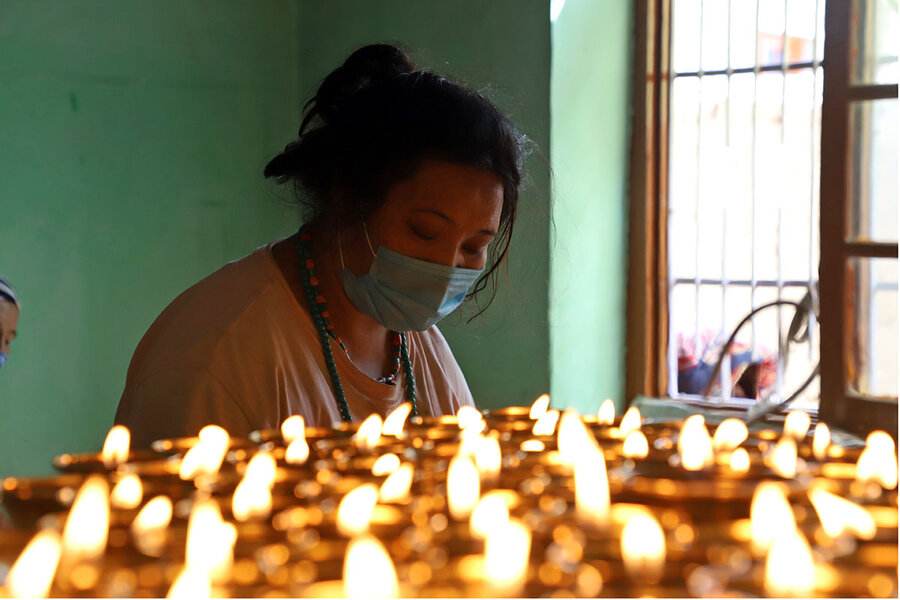For Tibetan refugees, the India-China border rift is personal
| Leh, India
In a tiny room of her brother’s house, surrounded by female relatives, Tsering Tsomo is pouring oil in dozens of brass lamps, keeping them alight in his memory. For 49 days after his death, the family will host monks and relatives here at his home in Choglamsar, India, lighting incense and offering prayers. Wearing trousers and a T-shirt, prayer beads hanging from her neck, Ms. Tsomo whispers Buddhist prayers for peace for her brother’s soul, sometimes shuffling her beads.
Tenzin Nyima was killed late last month in a mine blast more than 100 miles away, near the Line of Actual Control, the de facto border between India and China. The two nuclear-powered countries have been in a standoff since May over their disputed border in the western Himalayas. At least 20 Indian soldiers have been killed in clashes, and both armies have accused the other of incursions, with warning shots fired in early September.
But Mr. Nyima’s death, in particular, has brought attention. Like several Tibetans in Choglamsar, he had joined India’s Special Frontier Force (SFF), a covert unit composed mostly of Tibetan refugees. Some 90,000 Tibetans live in India today, after their families fled following a failed uprising against China’s rule. And after decades here, many say they deserve greater support from New Delhi. As the rest of the world eyes the border tension nervously, they hope the attention could prompt change for their homeland – though many analysts find that unlikely.
India has benefited immensely from Tibetans’ presence, says Dibyesh Anand, professor of international relations and an expert on Tibet at the University of Westminster in London: from rejuvenating monasteries, to improving India’s soft power as the adopted home of the Dalai Lama, and offering legitimacy to New Delhi’s border claims.
But “most Indians are not even aware of Tibetan contributions,” he says, reflecting India’s balancing act: how to support Tibetan refugees, without Beijing accusing New Delhi of meddling in internal affairs. The community’s low profile is “reflective of a conscious government policy to not highlight Tibetan presence, and avoid accusation of using the ‘Tibet card’ vis-à-vis China.”
Yet as Indian and Chinese forces prepare for the coming harsh winter, Tibetan residents of Choglamsar watch the Indian fighter jets flying above, still hoping for a “free Tibet.”
Caught in limbo
Choglamsar is a cluster of one-story mud brick houses, with a monastery atop its foothill. From the monastery, one can see the whole town on the banks of the Indus River – 11,000 feet up, surrounded by mountains. On one end of the hill, painted stones spell out “Save Tibet” near a community center, where residents queue to get tested for COVID-19. A Tibetan flag is waving on the top of the center.
A month before leaving for the border, Mr. Nyima had visited his older brother Tenzin Namdakh here, the town where they’d lived for 20 years. Sitting in the courtyard of his brother’s house, Mr. Namdakh recalls him saying, “I don’t know whether I will be back or not; you stay well. I’m being posted at the border, so take care of my family, because there is no guarantee.”
Mr. Nyima was given a grand public funeral in nearby Leh, attended by Indian officials. It was the first time a Tibetan in India had been recognized for military service, though the government did not issue a statement.
Many Tibetan residents say that silence makes them feel used – particularly young Tibetans, like Thinley Choedon. She studies journalism, and believes that it is time for India to strengthen its stance on Tibet.
“The Indian government has been playing with us,” she says. “Many generations have already passed and we have fought the Kargil War and Bangladesh War for India. The Indian government must realize how much they have used us.”
By some measures, India has shown long-standing support for Tibetans who fled across the border, and their descendants. The Dalai Lama and Tibet’s government in exile are based in Dharamsala, 400 miles south, and there are dozens of Tibetan settlements across the country.
But refugees lack full citizenship rights, and even those eligible to apply often prefer not to. Without citizenship, most cannot join government services except the army, and many rely on livestock or menial jobs. Just 10 years ago, there were 150,000 Tibetans living in India, but many have migrated further.
“The income of many families also depends on their children’s jobs; many have joined the Indian army. That helps the Tibetan community,” says Tseten Wangchuk, the Tibetan government in exile’s representative for some 7,000 Tibetans in the area. In India, “we have our identity and we need to preserve our own culture. We have enough space here to protect our culture and religion.”
In 2003, India recognized the Tibet Autonomous Region as part of China, and said it would not allow “anti-China political activities.” Some argue that India should press on the Tibet issue, but the government has held back, concerned about Chinese reprisals. In 2018, the government stopped officials from attending a public event held by the Tibetan government in exile, saying such participation “is not desirable and should be discouraged.”
“My heart is in Tibet”
Three miles from Choglamsar, in Leh, is a Tibetan Refugee Welfare Association market: a small area with makeshift shops lining each side of the aisles, with jackets, trousers, and Buddhist prayer flags hanging. At one end, in a corner, Sonam Tsering waits for customers behind a pile of jackets. A headband with “Free Tibet” written over it is hanging on his right side, just below the framed photographs of Tibet’s spiritual leader, the Dalai Lama.
Mr. Tsering, a former SFF soldier, still recalls his own time serving at the border, when “there was no war.” After migrating from Tibet, his parents settled in Karnataka, a southern Indian state. But for the past 20 years, he has been traveling to Leh to run his shop from March to December.
“It has been a long time here so India feels like my country, but my heart is in Tibet. Some Tibetans have taken Indian citizenship, but I didn’t because I won’t be part of the Tibet community then anymore. No one in my family has taken citizenship,” he says.
During the peak tourist season in Leh, Mr. Tsering typically earns at least $800 a month. The pandemic and the clashes have kept tourists away, and this year he hasn’t even made half that. Yet if tensions continue, he hopes “it can help get Tibet freedom.”
Currently, India’s diplomacy does not stress either human rights in Tibet or Tibetans’ demands for self-determination, Professor Anand says. But given their existential crisis as a community, as the years in India go by, “they have to engage with whatever opportunity they have for their identity to be recognized.”
Ms. Choedon, the journalism student, expresses a similar view. The first thing for New Delhi is to “accept that [the border tension] is not an India and China problem but an Indo-Tibet border issue. This is a chance; people of Tibet have got their own image now.”






